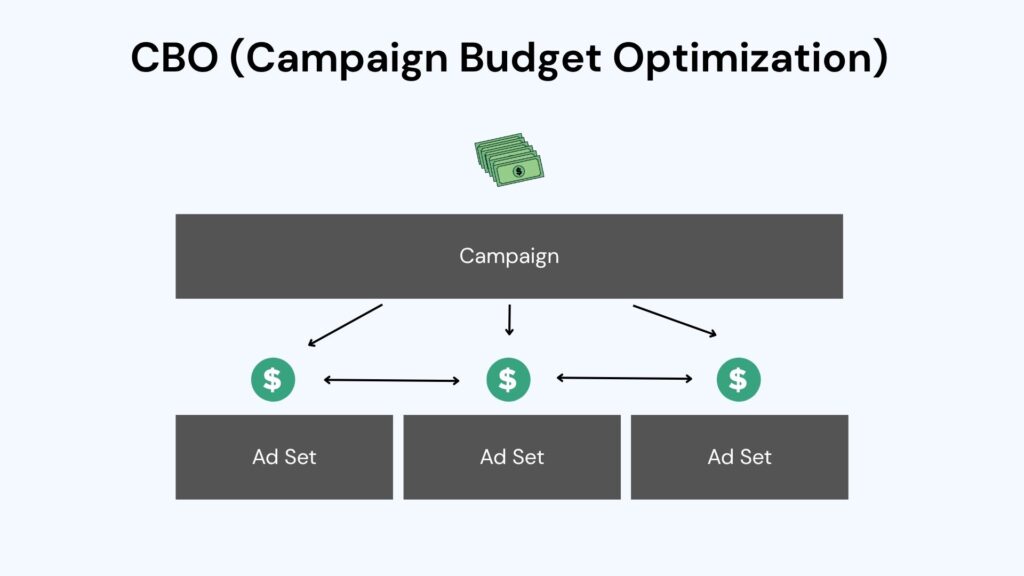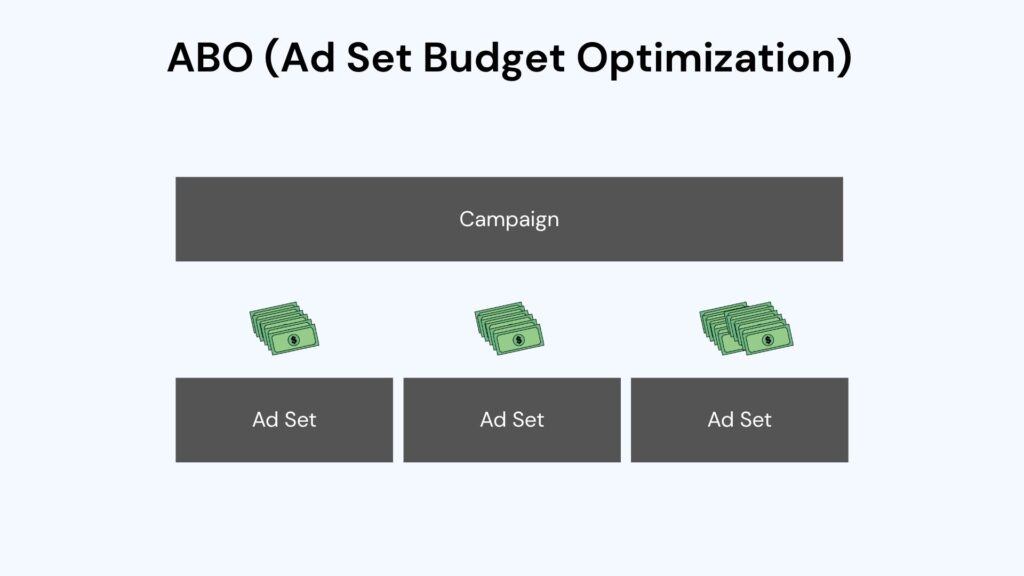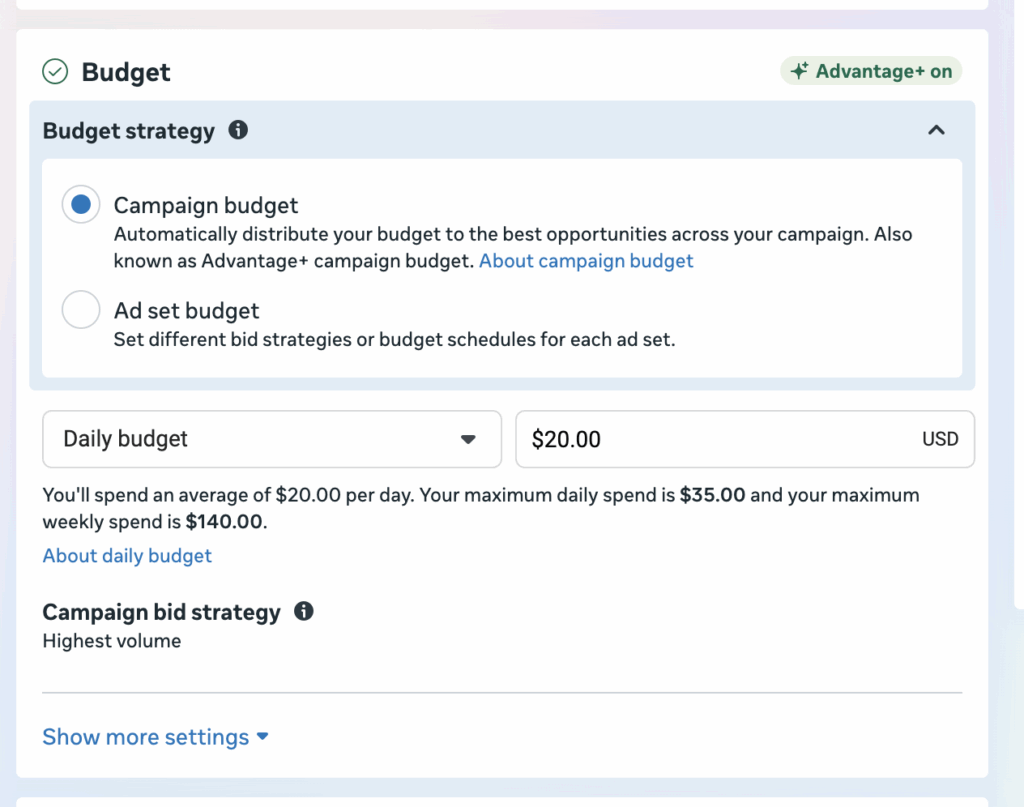Have you ever launched a Facebook sales campaign and wondered whether to choose CBO or ABO? You’re not alone. Choosing the right budget strategy is one of the most important levers you can pull when setting up your Meta sales objective campaigns.
The difference between Campaign Budget Optimization (CBO) and Ad Set Budget Optimization (ABO) may seem subtle at first, but it can dramatically impact how efficiently your budget is spent—and how many conversions you drive.
In this article, we’ll break down how each approach works, when to use one over the other, and why Meta is increasingly nudging advertisers toward a more flexible, AI-optimized campaign structure.
Campaign Budget Optimization (CBO)
Campaign Budget Optimization—or CBO—is a setting that allows Meta to manage your budget across all ad sets in a campaign. Rather than assigning fixed budgets to individual ad sets, you give Meta a single campaign-level budget, and it automatically shifts spend between ad sets based on performance.
This approach relies heavily on Meta’s machine learning to find efficiency: the system reallocates funds to the top-performing ad sets in real-time.

When to Use CBO
CBO is ideal when you:
- Are testing multiple audiences or creatives and want Meta to allocate spend dynamically
- Want to reduce manual campaign management
- Are running evergreen sales campaigns where optimization over time improves results
- Trust Meta’s algorithm to find the most cost-effective route to conversions
Pros and Cons of CBO
Pros:
- Efficiency: Meta automatically reallocates budget to the best-performing ad sets in real time, ensuring efficient use of your overall campaign spend.
- Scale: Great for larger campaigns with multiple ad sets
- Simplicity: Easier to manage at scale with fewer manual tweaks
Cons:
- Less control: You can’t fine-tune budget distribution
- Needs volume: Performance may lag if your campaign doesn’t generate enough conversion signals
- Learning phase volatility: If not properly structured, CBO campaigns can struggle to exit the learning phase
Ad Set Budget Optimization (ABO)
ABO gives you more granular control. With this method, you assign a specific budget to each ad set. Meta will spend the full amount on each one, regardless of how it’s performing compared to others in the same campaign.
This can be useful when you want to test audiences, placements, or creatives in isolation, or when you have strict rules around spend distribution.

When to Use ABO
ABO is a smart choice when you:
- Want to control budget by segment (e.g., retargeting vs. prospecting)
- Need predictable spend per audience
- Need to ensure specific ad sets get spend
- CBO prioritizes the lowest-cost conversions—not the highest-value ones for your business
Pros and Cons of ABO
Pros:
- Full control: You decide how much budget goes where
- Useful for testing: Ideal for running clean experiments between audiences or creatives
- Easier for attribution analysis: Since spend isn’t shifting dynamically, results are easier to compare
Cons:
- No optimization between sets: Meta won’t shift budget based on performance, leaving sales on the table
- Manual work: Requires frequent check-ins and adjustments
- Potential inefficiency: Underperforming ad sets still spend their full budget
How to Choose Between CBO vs ABO
Choosing between CBO and ABO ultimately depends on your campaign goals, timeline, and budget size.
Use CBO when:
- You have multiple ad sets and want Meta to optimize dynamically
- You’re focused on long-term performance and scalability
- You have enough budget to generate statistically significant results
Use ABO when:
- You’re testing new audiences or creatives
- You need rigid control over where your dollars go
- You’re running short-duration sales campaigns and can’t afford misallocated spend
But what if you want the best of both worlds?
Meta gives you a middle ground through CBO with minimum and maximum spend limits at the ad set level. This setup allows you to define a floor (min) and/or a ceiling (max) for each ad set’s budget while still letting Meta optimize within those bounds.
It’s a powerful option when:
- You want to ensure certain audiences get guaranteed spend
- You’re cautious about overspending on new or unproven segments
- You want optimization, but not at the expense of strategic control
This hybrid approach gives you the efficiency and automation of CBO, without fully giving up budget control across your ad sets.
How to Enable CBO for Your Campaign
Meta makes it relatively easy to enable CBO, though it’s important to set things up correctly to ensure optimal performance.
Here’s how to enable CBO:
- Create a new campaign in Ads Manager
- Choose “Sales” as your objective
- Under Campaign Settings, toggle “Campaign Budget Optimization” to ON

- Set your daily or lifetime budget at the campaign level
- Add your ad sets underneath and let Meta handle the rest
Important: Make sure your campaign has enough conversion volume to exit the learning phase. Meta typically recommends at least 50 conversions per week per ad set.
CBO Today, Advantage Plus Tomorrow: What Meta’s Really After
If it feels like Meta is nudging you toward CBO, it’s because they are.
CBO is a stepping stone to Advantage+ Shopping Campaigns, Meta’s newer ad format that pushes automation to its limit—automating placements, creative selection, audience targeting, and budget allocation.
This reflects Meta’s broader vision: to reduce advertiser input on tactical decisions and allow its machine learning to make real-time optimizations. By minimizing manual constraints (such as fixed ad set budgets), Meta’s AI can better identify conversion opportunities and shift spend accordingly.
With Advantage+ and CBO, Meta wants advertisers to focus on strategy and creative, not micromanaging where the dollars go.
Conclusion
Choosing between CBO and ABO isn’t just a technical setting—it’s a strategic decision that impacts how your budget is spent and how your campaigns perform.
If you’re running Facebook ads with the Sales objective, think carefully about your budget size, your testing strategy, and your appetite for automation.
- ABO gives you more control, better for testing and predictable spend.
- CBO offers better efficiency and scale, especially when paired with strong creative and enough budget to let the algorithm work.
Meta is clearly signaling that the future lies in flexible, AI-driven campaign structures. By learning to use CBO effectively today, you’ll be better prepared for where Facebook Ads are headed tomorrow.



